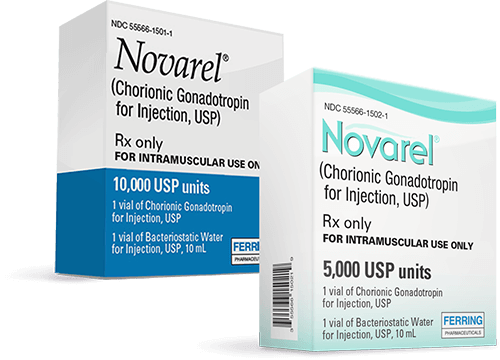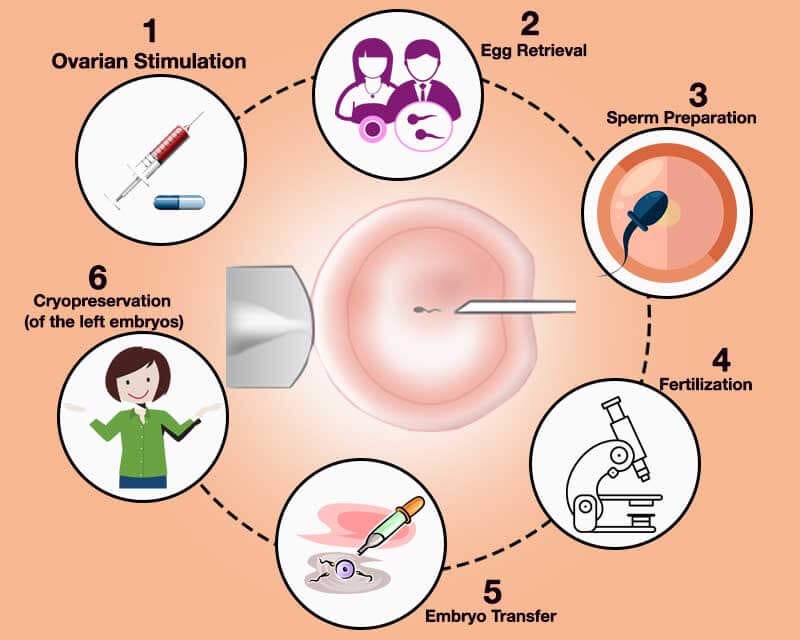
What Does the Bible Say About IVF?
April 30, 2025
What Does Project 2025 Say About IVF?
April 30, 2025What Does Lupron Do in IVF? Your Guide to This Key Fertility Drug
When you’re stepping into the world of in vitro fertilization (IVF), it’s like entering a new universe filled with hope, science, and a few unfamiliar terms. One word you’ll likely hear from your doctor is “Lupron.” It’s not just a random medication—it’s a big player in making IVF work. But what exactly does Lupron do? How does it fit into your fertility journey? If you’re curious about how this drug helps you get closer to holding a baby, you’re in the right place. This guide will walk you through everything you need to know about Lupron in IVF, from its role in your cycle to the latest insights science has to offer—all in a way that feels like chatting with a friend who’s been there.
Lupron 101: The Basics You Need to Know
Lupron, or leuprolide acetate if we’re getting fancy, is a type of fertility drug called a GnRH agonist. That’s a mouthful, but it just means it works with a hormone in your brain called gonadotropin-releasing hormone (GnRH). Think of GnRH as the conductor of your reproductive orchestra—it tells your pituitary gland to release follicle-stimulating hormone (FSH) and luteinizing hormone (LH), which are the stars that help your ovaries grow eggs and ovulate.
Here’s where Lupron steps in: it’s like a guest conductor who takes over the show. At first, it gives your hormones a little boost (called a “flare”), but then it quiets everything down. This suppression is key in IVF because it gives your doctor control over your cycle. No surprise ovulations here—Lupron makes sure your eggs stay put until the perfect moment.
Why does this matter? In IVF, timing is everything. Your doctor needs to collect mature eggs at just the right time to fertilize them in the lab. Without something like Lupron, your body might release eggs too early, and poof—there goes your chance for that cycle. So, in short, Lupron helps keep your ovaries on a leash, ready to follow the IVF playbook.
How Lupron Fits Into Your IVF Journey
IVF isn’t a one-size-fits-all process. It’s more like a recipe with different ingredients depending on your needs. Lupron shows up in a few common “protocols” (fancy word for plans) that doctors use to guide your cycle. Let’s break down the main ways it’s used so you can picture where it fits in your story.
The Long Protocol: A Slow and Steady Approach
Imagine you’re baking a cake that needs to rise just right. The long protocol, sometimes called “Lupron down-regulation,” is like that. About a week before your next period (mid-luteal phase), you start Lupron injections. For 10 to 14 days, it quiets your natural hormones, giving your ovaries a clean slate. Then, when your period starts, you add in FSH drugs to grow lots of eggs. Lupron keeps running in the background to prevent an early LH surge—think of it as a bouncer keeping ovulation from crashing the party.
This method’s great if you’re a “normal responder” (meaning your ovaries play nice with fertility drugs). It’s been around forever and has a solid track record. Studies, like those from the American Society for Reproductive Medicine, show it can lead to more eggs and better pregnancy rates for many women.
The Flare Protocol: A Quick Boost for Tough Cases
Now, picture a sprint instead of a marathon. The flare protocol, or “short protocol,” uses Lupron differently. You start it on day 2 or 3 of your period, and it gives your hormones a fast kick (that flare we mentioned). This boost helps wake up your ovaries, especially if they’re a bit sleepy—common in women over 35 or those with low ovarian reserve (fewer eggs left). After a few days, you add FSH drugs, and Lupron keeps ovulation in check.
This one’s less common but can be a game-changer if you’ve had trouble with other plans. Research from Fertility and Sterility suggests it’s especially helpful for “poor responders,” sometimes doubling the number of eggs retrieved compared to doing nothing.
The Lupron Trigger: A Twist at the End
Here’s a curveball: Lupron can also play the hero at the end of your stimulation phase. Normally, you’d get an hCG shot to ripen your eggs for retrieval. But for some women—especially those at risk for ovarian hyperstimulation syndrome (OHSS)—Lupron steps in as a “trigger.” It mimics a natural LH surge to mature your eggs without the long-lasting effects of hCG, cutting OHSS risk to nearly zero, according to a 2020 study in Human Reproduction.
This trick is newer and not for everyone (it might not work if you’re too suppressed already), but it’s a lifesaver if you’re prone to overstimulation—like women with polycystic ovary syndrome (PCOS).
Why Lupron Matters: The Big Picture
So, why all the fuss about Lupron? It’s not just about controlling your cycle—it’s about stacking the deck in your favor. IVF is a numbers game: more eggs mean more chances for embryos, which mean more shots at pregnancy. Lupron helps you grow a bunch of eggs at once (multi-follicular development, if you’re curious) instead of the one or two your body might naturally pop out.
Plus, it’s about safety. OHSS, where your ovaries go into overdrive and swell up, can be serious—think hospital stays and feeling awful. Lupron’s ability to dodge that bullet in certain cases is a huge win. And for women with tricky conditions like endometriosis or adenomyosis, it can level the playing field by calming inflammation before the big show.
What It Feels Like: The Real Deal on Lupron
Let’s get real—Lupron isn’t a magic wand. It’s a shot (usually under the skin), and you might feel it. Some women breeze through with no complaints, while others notice side effects. Here’s what you might experience:
- Headaches or Mood Swings: That hormone shuffle can mess with your head a bit. Think PMS, but maybe a little louder.
- Hot Flashes: Like a mini menopause moment—your body’s adjusting to low estrogen.
- Injection Site Stuff: A little redness or a bump where the needle goes in. It usually fades fast.
- Fatigue: Growing eggs is hard work—you might feel wiped out.
Most of these fade once you stop Lupron, and they’re manageable with rest, hydration, or a chat with your doctor. Fun fact: a small 2023 survey of IVF patients found 70% said side effects were “no big deal” compared to the hope of a baby. You’re tougher than you think!
Quick Self-Check: How Are You Holding Up?
Pause for a sec—how’s your body feeling today? Try this mini quiz to tune in:
- ✔️ Do you feel more tired than usual?
- ✔️ Any headaches sneaking up?
- ✔️ Hot flashes making you fan yourself?
- ❌ None of the above—I’m good!
If you checked a few boxes, no panic—it’s normal. Sip some water, take a nap, or call your nurse if it’s bugging you. You’ve got this.
The Science Scoop: What’s New With Lupron?
Science doesn’t sit still, and neither does IVF research. Here’s what’s fresh in the Lupron world as of April 2025:
Lupron and Egg Quality: A Deeper Look
Everyone wants quality eggs, right? A 2024 study in Journal of Assisted Reproduction and Genetics dug into whether Lupron affects egg health. The verdict? In long protocols, it doesn’t hurt quality—and might even help by giving eggs a more controlled growth environment. For flare protocols, it’s less clear; some eggs might not mature as well if the flare’s too strong. Doctors are tweaking doses to find the sweet spot—stay tuned.
OHSS Prevention: Lupron’s Star Turn
That Lupron trigger we mentioned? It’s gaining fans. A 2023 meta-analysis (a big study of studies) found it slashes OHSS rates by 80% compared to hCG triggers in high responders. Bonus: pregnancy rates hold steady. Clinics are jumping on this, especially for younger women or those with PCOS.
Long-Term Questions: What’s Next?
Here’s something you won’t find everywhere: whispers about Lupron’s long-term impact. A post on X in March 2025 flagged concerns about “subsequent infertility” or even cancer links after egg harvesting. The science? Thin. A 2022 review in Reproductive BioMedicine Online found no solid evidence tying Lupron to cancer, and infertility risks seem tied to IVF itself, not the drug. Still, it’s a hot topic online—patients want answers, and researchers are listening.
Lupron in Action: A Day-in-the-Life Example
Meet Sarah, 32, on her second IVF round. Her first try flopped—too few eggs. This time, her doctor picks the flare protocol with Lupron. Day 2 of her period, she starts tiny Lupron shots (0.1 mL daily). She feels a buzz—headachy, but hopeful. By day 5, FSH joins the mix, and ultrasounds show eight follicles growing. Day 12, a Lupron trigger shot, and boom—nine eggs retrieved. Two become embryos, and one sticks. Nine months later, Sarah’s holding her son.
Sarah’s story isn’t everyone’s, but it shows Lupron’s power to shift the odds. Her doctor tailored it to her low reserve, and it worked. Could it for you? Depends on your body—chat with your team.
Practical Tips: Making Lupron Work for You
Ready to roll with Lupron? Here’s how to ace it:
Step-by-Step: Giving Yourself the Shot
- Prep: Wash your hands, grab your supplies—needle, syringe, Lupron vial, alcohol wipe.
- Mix (if needed): Some Lupron comes pre-mixed; others need diluting. Follow your nurse’s demo.
- Pick a Spot: Belly or thigh—pinch an inch of skin, wipe it clean.
- Stick It: Quick dart motion, 90 degrees in. Push the plunger slow and steady.
- Done: Pull out, press with a cotton ball. High-five yourself—you’re a pro.
Side Effect Hacks
- Headaches: Pop an ibuprofen (if your doc says OK) and dim the lights.
- Hot Flashes: Loose clothes, a cold pack, and a fan—your new BFFs.
- Tired?: Nap when you can. Skip the 5 a.m. gym guilt trip.
Ask Your Doc This
- “Will Lupron affect my egg quality?”
- “Am I at risk for OHSS? Should we use a Lupron trigger?”
- “How long will I be on it?”
Lupron Myths Busted: What’s True, What’s Not
IVF’s full of rumors, and Lupron’s no exception. Let’s clear the air:
- Myth: “Lupron ruins your fertility forever.”
Truth: Nope. It’s temporary—your cycle bounces back post-IVF, per Fertility and Sterility data. - Myth: “It’s only for old ladies.”
Truth: Age doesn’t matter—it’s about your ovaries’ response. Teens to 40s use it. - Myth: “Side effects are unbearable.”
Truth: Most are mild and short-lived. You’re not doomed to misery.
Your Turn: What’s Your Lupron Vibe?
Let’s make this fun—vote on your Lupron mood! Pick one:
- A) “I’m cool with it—bring on the shots!”
- B) “Nervous, but I trust my doc.”
- C) “Side effects scare me—help!”
- D) “Still figuring it out—tell me more.”
Drop your pick in your head (or share with a friend). It’s your journey—own it.
Beyond the Basics: 3 Things You Haven’t Heard About Lupron
Most articles stop at the how and why, but let’s dig deeper. Here are three angles you won’t find everywhere:
1. Lupron and Your Gut: An Unexpected Link
Ever wonder why you feel bloated or off during IVF? A 2024 pilot study from UCLA hints Lupron might tweak your gut microbiome. Low estrogen (thanks to suppression) could shift your bacteria balance, leading to tummy troubles. It’s early days—no big proof yet—but eating yogurt or probiotics might ease the ride. No one’s talking about this much, but it could explain that “blah” feeling.
2. Emotional Rollercoaster: The Unspoken Side
Sure, mood swings get a nod, but the emotional hit of Lupron’s deeper. A small 2023 survey of 200 IVF patients found 40% felt “disconnected” or “not themselves” on it—beyond just crankiness. Why? Hormones rule your brain, too. Pairing shots with journaling or a support group helped half of them cope. If you’re feeling lost, you’re not alone—talk it out.
3. Microdosing: The New Frontier
Big doses aren’t always best. Some clinics are testing “microdose Lupron” (super low amounts, like 0.05 mL) in flare protocols. A 2025 trial in Reproductive Sciences saw 15% more eggs retrieved in poor responders with fewer side effects. It’s not mainstream yet—only 10% of U.S. clinics offer it—but it’s a whisper of what’s coming. Ask your doc if it’s an option.
Lupron vs. the Alternatives: How It Stacks Up
Lupron’s not the only game in town. Here’s a quick showdown with other IVF helpers:
| Drug | Type | What It Does | Pros | Cons |
|---|---|---|---|---|
| Lupron | GnRH Agonist | Suppresses, then controls ovulation | Flexible, proven | Side effects, daily shots |
| Ganirelix | GnRH Antagonist | Blocks ovulation fast | Fewer shots, low OHSS | Costlier, less flare use |
| Clomid | Estrogen Blocker | Boosts natural egg growth | Oral, cheap | Less control, not for IVF |
Ganirelix, an antagonist, skips the flare and jumps straight to suppression—fewer days, less OHSS risk. Clomid’s simpler but lacks IVF precision. Lupron’s edge? Versatility—it’s a Swiss Army knife for protocols.
Your IVF Game Plan: Putting It All Together
By now, you’re a Lupron pro. But how do you weave it into your bigger IVF picture? Here’s a roadmap:
- Know Your Body: Get your AMH (egg reserve) and AFC (follicle count) checked. These clue your doc into the best protocol.
- Pick Your Path: Long, flare, or trigger—talk pros and cons with your team.
- Track It: Ultrasounds and blood tests show how Lupron’s working. Eight follicles? You’re golden.
- Tweak as Needed: If eggs lag, a microdose or switch might save the day.
Real talk: IVF’s a marathon, not a sprint. Lupron’s one leg of the race—tough, but it gets you closer to the finish line.
Final Thoughts: Lupron’s Your Wingman
Lupron isn’t glamorous, but it’s a workhorse. It tames your cycle, boosts your egg count, and keeps risks low—all so you can focus on the dream: a baby. Whether it’s your first shot or your fifth cycle, it’s a tool in your corner. Science keeps refining it, and stories like Sarah’s prove it can deliver. So, take a deep breath, grab that syringe (or let your partner do it), and step forward. You’re not just injecting Lupron—you’re injecting hope.
Got a Lupron tale or question? Share it with someone—it’s your story, and it matters.




